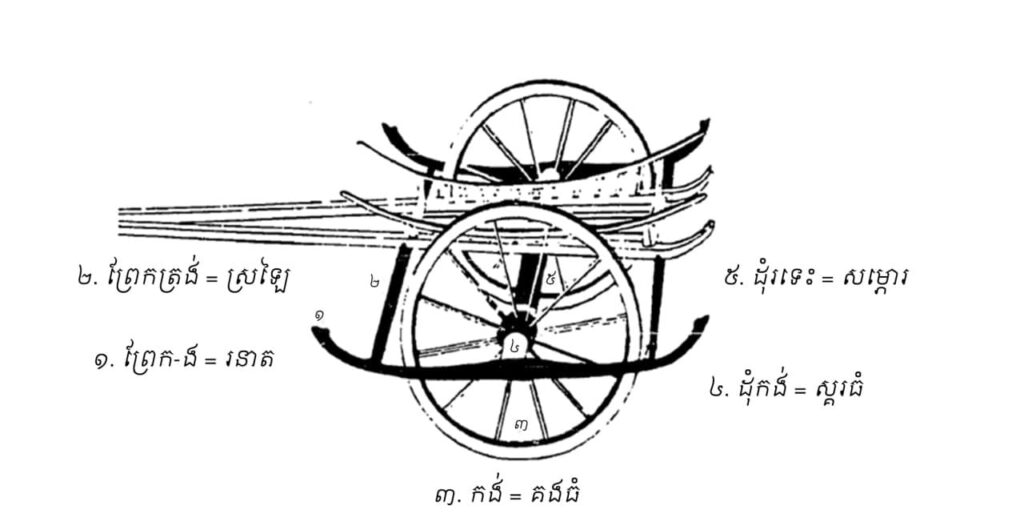យើងមានពាក្យបុរាណនិងរឿងព្រេងនិទានមួយចំនួន ដែលពាក់ព័ន្ធនឹងឧបករណ៍និងវង់តន្ត្រីខ្មែរ។ តាមពាក្យក្នុងតម្រានាដសាស្រ្តថា “សម័យមួយព្រះឥសូរទ្រង់គង់កណ្តាលទេវសភាដែលឋិតនៅលើកំពូលភ្នំកៃលាស មានបំណងនឹងសម្តែងពិធីរាំ ឱ្យជាបែបច្បាប់សម្រាប់លោក ទើបស្តេចត្រាស់បង្គាប់ឱ្យព្រះនាងឧមាទេវីគង់លើសុវណ្ណបល្ល័ង្ក ឱ្យនាងសរស្វតី ជាទេពីព្រះព្រហ្ម ដេញពិណ ឱ្យព្រះឥន្ទ្រផ្លុំខ្លុយ ឱ្យព្រះព្រហ្មគោះឈឹង ឱ្យព្រះលក្ម្សី ជាទេពីព្រះនារាយណ៍ច្រៀង ឱ្យព្រះនារាយណ៍វាយថូន និងព្រះឥសូរព្រះអង្គឯងរាំ ដើម្បីឱ្យទេវតា គន្ធព្វ យក្សទាំងឡាយ ដែលឡើងទៅគាល់ព្រះអង្គមើលគ្រប់គ្នា”។
វង់តន្ត្រីពិណពាទ្យ ជាវង់តន្ត្រីដែលមានអាយុកាលចាស់នៅក្នុងចំណោមវង់តន្ត្រីខ្មែរ។ យើងមានវង់តន្ត្រីពិណពាទ្យពីរប្រភេទ គឺវង់តូចនិងវង់ធំ។
ពិណពាទ្យវង់តូច ឬ ពិណពាទ្យអង្គ៥ ឬ គ្រឿង៥៖
១. រនាតឯក ២. គងធំ ៣. ស្រឡៃធំ ៤. សម្ភោរ ៥. ស្គរធំ
រឿងព្រេងពាក់ព័ន្ធនឹងវង់តន្ត្រីពិណពាទ្យអង្គ៥ ដំណាលថា៖
«មានថ្ងៃមួយ ព្រះឥន្ទ្រលោកអផ្សុក ក៏ត្រាស់ប្រើឱ្យបវេសកម្មរៀបចំរាជរថនាំព្រះអង្គ ទៅក្រសាលព្រៃ។ នៅពេលធ្វើដំណើរ ព្រះអង្គបានឮសូរលាន់ចេញពីរាជរថ រួចក៏បញ្ជាឱ្យគេធ្វើឧបករណ៍តន្ត្រីត្រាប់តាមសូរ នៃចំណែកផ្សេងៗនៃរាជរថនោះ គឺ៖
ព្រែក-ង ជា រនាត
ព្រែកត្រង់ ជា ស្រឡៃ
កង់ ជា គងវង់
ដុំរទេះ ជា សម្ភោរ និង
ដុំកង់ ជា ស្គរធំ»
មានរឿងព្រេងមួយទៀតដែលពាក់ព័ន្ធនឹងវង់តន្ត្រីពិណពាទ្យ និទានថា៖
«វាយគោពីរ ស៊ីដុំរទេះ
គោមួយប្រឡាក់ផេះ កេះដោះនាង
ផ្អៀងមើលឫស្សី សំឡេងដូចរៃ
សម្តីមួយៗ។»
«វាយគោពីរ» គឺវាយស្គរធំពីរ
«ស៊ីដុំរទេះ» គឺផ្លុំស្រឡៃ
«គោមួយប្រឡាក់ផេះ» គឺ បិទបាយសម្ភោរ
«កេះដោះនាង» គឺវាយដោះគង គឺគងវង់
«ផ្អៀងមើលឫស្សី សំឡេងដូចរៃ សម្តីមួយៗ»
គឺលេងរនាត។
តន្ត្រីពិណពាទ្យវង់ធំបច្ចុប្បន្ន មានរនាតឯក រនាតដែក រនាតធុង គងតូច គងធំ ស្រឡៃតូច ស្រឡៃធំ សម្ភោរ ស្គរធំ និងឈឹង ដែលស្ទើរតែទាំងអស់ លើកលែងតែរនាតចេញ គឺមានឆ្លាក់នៅលើជញ្ជាំងប្រាសាទអង្គរវត្ត ថែវខាងជើង។
ពាក់ព័ន្ធនឹងឧបករណ៍តន្ត្រី «ចាប៉ី» តាមពាក្យអ្នកចេះធ្វើគ្រឿងភ្លេងបុរាណខ្លះ និងតាមសម្តីគ្រូភ្លេងខ្លះថា ចាប៉ីនីមួយៗ មិនមែនចេះតែធ្វើឱ្យតែបាននោះទេ។ ចាប៉ីដែលមានសូរនិងសំឡេងពីរោះទាក់ចិត្តអ្នកស្តាប់ត្រូវធ្វើ ស្នូកដោយឈើរាំង ធ្វើដងដោយដើមក្រសាំង ធ្វើសន្ទះដោយដើមខ្ទម្ព ធ្វើគង្គក់ដោយដើមធ្នង់ និងធ្វើខ្ទង់ដោយឆ្អឹង ទើបដាក់ខ្សែដេញទៅលាន់ឮសូរពីរោះ។ ម្យ៉ាងវិញទៀត គេមានជំនឿថាឧបករណ៍ចាប៉ីនេះ មានព្រាយកាន់ផង។ ដូចមានពាក្រចាស់ពោលថា៖
«ស្នូករាំង ដងក្រសាំង
សន្ទះខ្ទម្ព គីង្គក់ធ្នុង
ខ្ទង់ឆ្អឹង»។
ពាក្យបុរាណក៏ដូចជារឿងនិទាន មានសារៈសំខាន់ណាស់ ព្រោះវាក៏ជាប្រវត្តិសាស្ត្រដោយការបកស្រាយឬពិពណ៌នាតាមមាត់។ ពាក់ព័ន្ធនឹងឧបករណ៍និងវង់តន្ត្រីខ្មែរ ពាក្យបុរាណនិងរឿងនិទានទាំងនេះ ផ្តល់ជាប្រវត្តិសាស្ត្រ ជាព័ត៌មាន ជាគតិបណ្ឌិត គំនិតគិត និងច្នៃប្រឌិត ព្រមទាំងជារូបមន្តផ្សែផ្សំវត្ថុធាតុ ដើម្បីផលិតចេញឱ្យទៅជាឧបករណ៍តន្ត្រីខ្មែរ។ មិនគ្រាន់តែប៉ុណ្ណោះ ពាក្យពេចន៍បុរាណខាងលើនេះ បុព្វបុរសខ្មែរមានភាពឆ្លាតវែនិងទេពកោសល្យ ដែលលោកបានរៀបចំតាក់តែងជាកំណាព្យកាព្យឃ្លោងឱ្យមានសោភ័ណដោយបង្កប់នូវអត្ថន័យខ្លឹមសារ ដើម្បីឱ្យអ្នកអានមានភាពងាយស្រួលក្នុងការទន្ទេញឱ្យចេះចងចាំផង៕
—————————————————
Legend and Khmer Music
There is a number of sayings and legends relating to music found in Cambodia. A dance manual describes, “Once upon a time, Lord Shiva residing in the middle of the godly gathering on Mount Kailasa, intended to have a dance performance, then ordered Goddess Uama Vatey sitting on the golden throne, Goddess Sara Svati (Brahma’s consort) to play the harp, Lord Indra to play the flute, Lord Brahma to play the finger-cymbals, Goddess Lakshmi (Narayana’s consort) to sing, Lord Narayana to play the goblet drum, while Lord Shiva himself dances to entertain all the gods, demigods (celestial musicians-Gandharva), and demons who came to attend to him (Pich 1970: 3).
The pinn peat ensemble is one of the oldest Khmer ensembles. In Cambodia, two sizes or instrumentations found: one small and the other large.
The small pinn peat ensemble with five instruments:
1 high-pitched xylophone
1 low-pitched circular-framed gong
1 low-pitched shawm/oboe
1 small double-headed barrel drum
1 pair of large double-headed barrel drums
The legend related to the pinn peat ensemble with five instruments goes:
One day, Lord Indra got bored, so he ordered Pavesakaim to prepare a chariot to take him for pass-time in the forest. On his trip, Lord Indra heard sounds coming from the chariot. Upon his return, he ordered musical instruments imitating the sounds of the chariot made.
Curved rod = Xylophone
Straight rod = Shawm
Wheel = Circular-framed gong
Cart axle = Small double-headed barrel drum
Wheel axle = Large double-headed barrel drum (Sam 1988: 27-28)
There is also another legend related to the pinn peat ensemble. Here it goes:
Beating two oxen Eating the rod
One ox smeared with ashes Picking a lady’s breast
Turning to look at the bamboo Sounding like the cicada
Speaking slowly word by word.
Beating two oxen = Beating the two large-double-headed barrel drums
Eating the rod = Plying the shawm
One ox smeared with ashes = Applying the tuning paste on the drum’s heads
Picking a lady’s breast = Playing the knobbed gongs
Turning to look at the bamboo, Sounding like the cicada, Speaking slowly word by word
= Playing the xylophone (Sam 1988: 29)
The large pinn peat ensemble consists of one high-pitched xylophone, one low-pitched xylophone, one high-pitched circular-framed gong, one low-pitched circular-framed gong, one high-pitched shawm, one low-pitched shawm, one small double-headed barrel drum, one (pair) of large double-headed barrel drums, and one pair of finger-cymbals. Most of these instruments were carved on the stone-wall (north gallery) of the twelfth-century Angkor Vatt temple.
The long-necked lute (chapey dang veng), according to some musicians and instrument-makers, is carefully made. The one that produces good sounds must be properly built:
Resonator box from raing wood
Neck from krasaing
Resonator-cover from khtum
Bridge from thnung
Frets from bone. (Pich 1970: 18, Keo 2011: 32).
Old sayings and legends are important as they serve as an oral history. Concerning Khmer musical instruments and music, these sayings and legends provide a history, information, ideas, thoughts as well as formulae for the making and production of Khmer musical instruments. Moreover, these words of wisdom are uttered in poetic forms, making it easy and simple to learn and memorize.
អត្ថបទដើម៖ បណ្ឌិត សំ សំអាង








